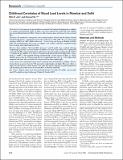| dc.contributor.author | Jain, Nitin | |
| dc.contributor.author | Hu, Howard | |
| dc.date.accessioned | 2011-04-25T14:28:27Z | |
| dc.date.issued | 2005 | |
| dc.identifier.citation | Jain, Nitin B., and Howard Hu. 2006. Childhood Correlates of Blood Lead Levels in Mumbai and Delhi. Environmental Health Perspectives 114(3): 466-470. | en_US |
| dc.identifier.issn | 0091-6765 | en_US |
| dc.identifier.uri | http://nrs.harvard.edu/urn-3:HUL.InstRepos:4875088 | |
| dc.description.abstract | Background: Lead exposure has previously been associated with intellectual impairment in children in a number of international studies. In India, it has been reported that nearly half of the children have elevated blood lead levels (BLLs). However, little is known about risk factors for these elevated BLLs. Methods: We conducted a retrospective cross-sectional analysis of data from the Indian National Family Health Survey, a population-based study conducted in 1998–1999. We assessed potential correlates of BLLs in 1,081 children who were < 3 years of age and living in Mumbai or Delhi, India. We examined factors such as age, sex, religion, caste, mother’s education, standard of living, breast-feeding, and weight/height percentile. Results: Most children (76%) had BLLs between 5 and 20 μg/dL. Age, standard of living, weight/height percentile, and total number of children ever born to the mother were significantly associated with BLLs (log transformed) in multivariate regression models. Compared with children ≤3 months of age, children 4–11 and 12–23 month of age had 84 and 146% higher BLLs, respectively (p < 0.001). A low standard of living correlated with a 32.3% increase in BLLs (p = 0.02). Children greater than the 95th percentile for their weight/height had 31% (p = 0.03) higher BLLs compared with those who were below the 5th percentile for their weight/height. Conclusions: Our study found various factors correlated with elevated BLLs in children. The correlation between greater than the 95th percentile weight/height and higher BLL may reflect an impact of lead exposure on body habitus. Our study may help in targeting susceptible populations and identifying correctable factors for elevated BLLs in Mumbai and Delhi. | en_US |
| dc.language.iso | en_US | en_US |
| dc.publisher | National Institute of Environmental Health Sciences | en_US |
| dc.relation.isversionof | doi:10.1289/ehp.8399 | en_US |
| dc.relation.hasversion | http://www.ncbi.nlm.nih.gov/pmc/articles/PMC1392244/pdf/ | en_US |
| dash.license | LAA | |
| dc.subject | children | en_US |
| dc.subject | India | en_US |
| dc.subject | lead | en_US |
| dc.title | Childhood Correlates of Blood Lead Levels in Mumbai and Delhi | en_US |
| dc.type | Journal Article | en_US |
| dc.description.version | Version of Record | en_US |
| dc.relation.journal | Environmental Health Perspectives | en_US |
| dash.depositing.author | Jain, Nitin | |
| dc.date.available | 2011-04-25T14:28:27Z | |
| dash.affiliation.other | HMS^Orthopedic Surgery-Brigham and Women's Hospital | en_US |
| dc.identifier.doi | 10.1289/ehp.8399 | * |
| dash.contributor.affiliated | Jain, Nitin | |


